A Nguba is a basket shield of the peoples of the Oubangui region in the Republic of Congo.

A Nguba is a basket shield of the peoples of the Oubangui region in the Republic of Congo.

This type of shield is found in many african ethnic groups, whether Bantu or not. [1] It is called nguba, guba, wara or gele according to these tribes. [2] It is made up of several layers of braided fibers and an oval piece of wood serves as a handle. This basketry work was traditionally reserved for men, except in the Ngiri and Poto where women could exercise it. [3] The name Nguba comes from the proto-bantu gùbà word which means «shield». The Obambas sometimes used animal skin to make them. [4]

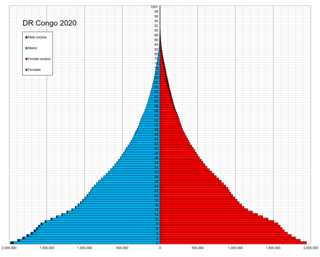
Demographic features of the population of the Democratic Republic of the Congo include ethnicity, education level, health, economic status, religious affiliations and other aspects of the population.
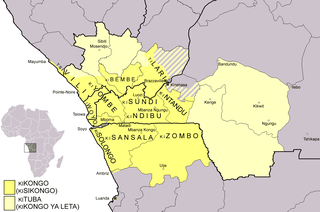
Kongo or Kikongo is one of the Bantu languages spoken by the Kongo people living in the Democratic Republic of the Congo (DRC), the Republic of the Congo, Gabon, and Angola. It is a tonal language. The vast majority of present-day speakers live in Africa. There are roughly seven million native speakers of Kongo in the above-named countries. An estimated two million more speakers use it as a second language.

The Atlantic–Congo languages are the largest demonstrated family of languages in Africa. They have characteristic noun class systems and form the core of the Niger–Congo family hypothesis. They comprise all of Niger–Congo apart from Mande, Dogon, Ijoid, Siamou, Kru, the Katla and Rashad languages, and perhaps some or all of the Ubangian languages. Hans Günther Mukarovsky's "Western Nigritic" corresponded roughly to modern Atlantic–Congo.
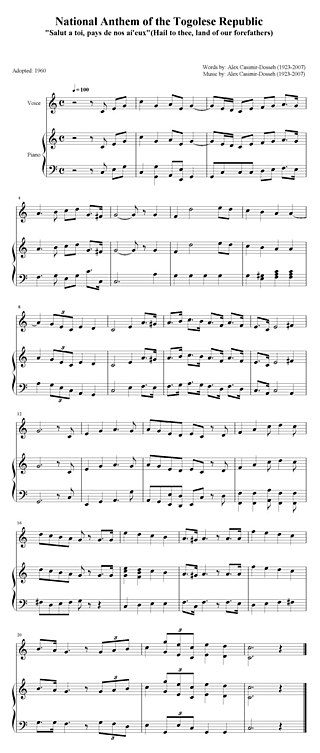
"Terre de nos aïeux" is the national anthem of Togo. The words and music were written by Alex Casimir-Dosseh, and it was the national anthem from independence in 1960 until 1979. In 1979, it was replaced in its capacity by a different composition created by the party of the Rally of the Togolese People. It was readopted in 1992.
Kituba is a widely used lingua franca in Central Africa. It is a creole language based on Kikongo, a Bantu language. It is a national language in Republic of the Congo and Democratic Republic of the Congo.
Bushi is mainly a traditional region and an African ethnic group in the eastern part of the Democratic Republic of the Congo ; mainly located in the South Kivu province. It lies along the Mitumba Mountains and includes the administrative territories of Walungu, Kabare, Kalehe, Mwenga, Idjwi and Uvira surrounding Bukavu, which is its main city. There are about 7-12 million inhabitants in the region speaking the Mashi or Shi language. The Bushi is also a kingdom that is organized into many localities or sub-chiefdoms.
Mwezé Ngangura is a film director from the Democratic Republic of the Congo (DRC).
Asian diasporas in France or French Asians consist of foreign residents and French citizens originating from Asian countries living in France. French citizens of Asian descent primarily have ancestry from the former French colonies of Indochina, as well as China or Turkey. Other Asian ethnic groups found in France include other West Asians, South Asians, Japanese, and Koreans.

Kurabit is a traditional shield originating from the Mentawai Islands off the coast of West Sumatra, Indonesia.

Isabelle Leymarie is a French musicologist, writer, pianist, filmmaker, translator and photographer.
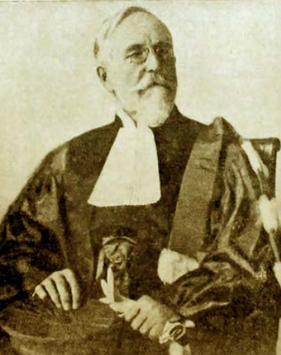
Clodomir Antony Vincent Houard (1873–1943) was a French botanist and entomologist whose chief interest was plant galls. He was Professor of Botany at the University of Strasbourg in 1940, and was the author of some 95 works on cecidology in 230 publications in 3 languages.

A Glagwa is a bell-shaped shield of the Wandala peoples of northern Cameroon.

An onzil is a throwing knife of ethnic groups from eastern Gabon.

A trumbash or trombash is a Mangbetu throwing knife from the Democratic Republic of Congo.
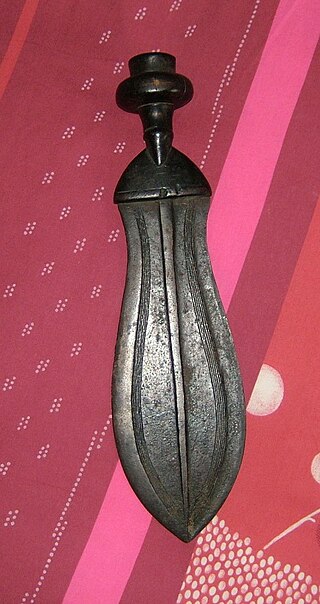
An ikul or ikula is a knife or a short sword of the Kuba of the Democratic Republic of Congo.
A roromaraugi is a parrying shield from San Cristobal Island in the Solomon Islands.

A qauata or qauaata is a parrying shield or war club of the San Cristobal Island in the Solomon Islands.
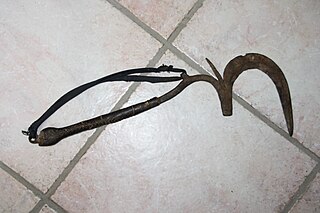
A sengese is a throwing knife of the Matakam from northeastern Nigeria or northern Cameroon.

A dwa or asesedwa or sometimes gwa is a stool of the Ashantis of Ghana.

Antoinette Dinga Dzondo is a Congolese politician who was the Republic of the Congo's Minister of Social Affairs and Humanitarian Action from 2016 to 2021.